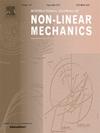Simulation of 3D turbulent flows using a discretized generative model physics-informed neural networks
IF 2.8
3区 工程技术
Q2 MECHANICS
International Journal of Non-Linear Mechanics
Pub Date : 2024-12-26
DOI:10.1016/j.ijnonlinmec.2024.104988
引用次数: 0
Abstract
Physics-informed neural networks (PINNs) demonstrated efficacy in approximating partial differential equations (PDEs). However, challenges arise when dealing with high-dimensional PDEs, particularly when characterized by nonlinear and chaotic behavior, such as turbulent fluid flows. We introduce a novel methodology that integrates domain discretization, a generative model in the Sobolev function space (), and a gating mechanism to effectively simulate high dimensional problems. The effectiveness of the method, Discretized Generative Model Physics-Informed Neural Networks (DG-PINN), is validated by its application to the simulation of a time-dependent 3D turbulent channel flow governed by the incompressible Navier–Stokes equations, a less explored problem in the existing literature. Domain discretization prevents error propagation by using different neural network models in different subdomains. The absence of initial conditions (IC) in subsequent time steps presents a challenge in identifying optimal network parameters. To address this, discretized generative models are used, improving the model’s overall performance. The global solutions’ regularity is enhanced compared to previous decomposition techniques by using the norm of error, rather than . The effectiveness of the DG-PINN is validated through numerical test cases and compared against baseline PINNs and traditional domain decomposition PINNs. The DG-PINN demonstrates improvement in both approximation accuracy and computational efficiency, consistently maintaining accuracy even at later time instances. Moreover, the implementation of a distributed training strategy, facilitated by domain discretization, is discussed, resulting in improved convergence rates and more optimized memory usage.
求助全文
约1分钟内获得全文
求助全文
来源期刊
CiteScore
5.50
自引率
9.40%
发文量
192
审稿时长
67 days
期刊介绍:
The International Journal of Non-Linear Mechanics provides a specific medium for dissemination of high-quality research results in the various areas of theoretical, applied, and experimental mechanics of solids, fluids, structures, and systems where the phenomena are inherently non-linear.
The journal brings together original results in non-linear problems in elasticity, plasticity, dynamics, vibrations, wave-propagation, rheology, fluid-structure interaction systems, stability, biomechanics, micro- and nano-structures, materials, metamaterials, and in other diverse areas.
Papers may be analytical, computational or experimental in nature. Treatments of non-linear differential equations wherein solutions and properties of solutions are emphasized but physical aspects are not adequately relevant, will not be considered for possible publication. Both deterministic and stochastic approaches are fostered. Contributions pertaining to both established and emerging fields are encouraged.

 求助内容:
求助内容: 应助结果提醒方式:
应助结果提醒方式:


